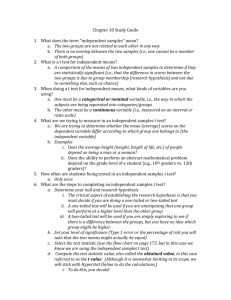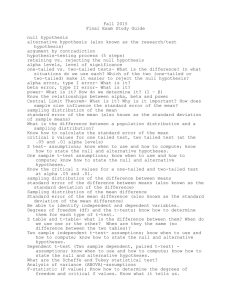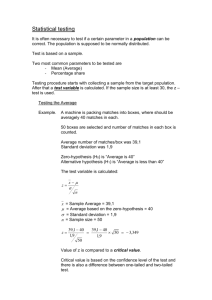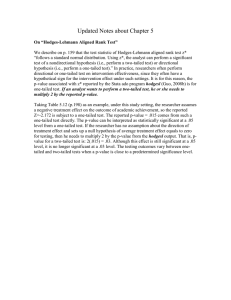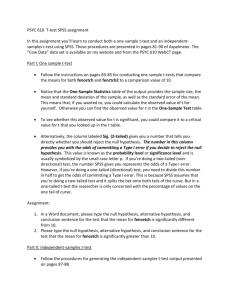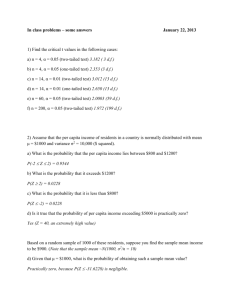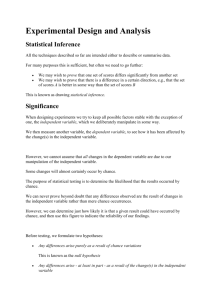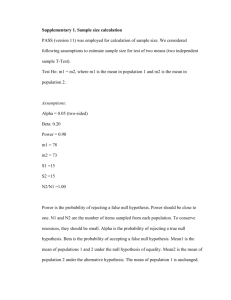tests
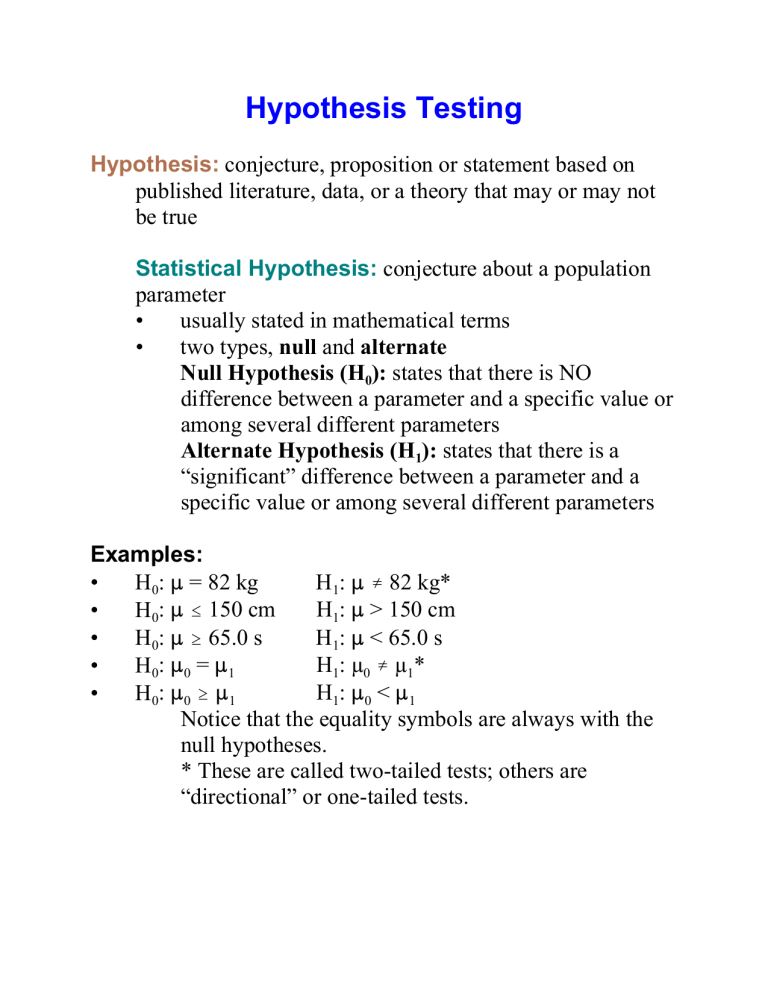
Hypothesis Testing
Hypothesis: conjecture, proposition or statement based on published literature, data, or a theory that may or may not be true
Statistical Hypothesis: conjecture about a population parameter
• usually stated in mathematical terms
• two types, null and alternate
Null Hypothesis (H
0
): states that there is NO difference between a parameter and a specific value or among several different parameters
Alternate Hypothesis (H
1
): states that there is a
“significant” difference between a parameter and a specific value or among several different parameters
Examples:
• H
• H
• H
• H
• H
0
:
:
= 82 kg H
0
:
: #
150 cm H
0
0
:
: $
65.0 s
:
:
0
:
:
0
0
=
:
$ :
1
1
H
H
H
1
:
: …
82 kg*
1
:
:
> 150 cm
1
:
:
< 65.0 s
1
: µ
0
…
µ
1
:
:
0
<
:
1
1
*
Notice that the equality symbols are always with the null hypotheses.
* These are called two-tailed tests; others are
“directional” or one-tailed tests.
Two-tailed vs One-tailed Tests
Two-tailed: also called a non-directional test
• null hypothesis rejected if sample mean falls in either tail
• most appropriate test especially with no previous experimentation
• less powerful than one-tailed
One-tailed: also called a directional test
• researcher must have reason that permits selecting in which tail the test will be done, i.e., will the experimental protocol increase or decrease the sample statistic
• more powerful than two-tailed since it is easier to achieve a significant difference
• fails to handle the situation when the sample means falls in the “wrong” tail
One-tailed, left One-tailed, right
Statistical Testing
To determine the veracity (truth) of an hypothesis a statistical test must be undertaken that yields a test value.
This value is then evaluated to determine if it falls in the critical region of a appropriate probability distribution for a given significance or alpha (
α
) level.
The critical region is the region of the probability distribution that rejects the null hypothesis. Its limit(s), called the critical value(s) , are defined by the specified confidence level (CL). The CL must be selected in advance of computing the test value. To do otherwise is statistical dishonesty. It is usual to perform a two-tailed test.
Instead of reporting significance levels (
α
= 0.05) or equivalent probabilities (P<0.05) many researchers report the test values as probabilities or P-values (e.g., P = 0.0455,
P = 0.253, P < 0.001, Not P=0.000). Advanced statistical programs report P-values, if not, use P<0.05 or P<0.01.
Truth table:
Test rejects H
0
(accepts H
1
)
Test does not reject
H
0
(accepts H
0
)
H
0
is true and
H
1
is false
Error (
α
) ;
Type I error
Correct (1 –
α
) ;
(experimental treatment failed)
H
0
is false and
H
1
is true
Correct (1 –
β
) (
(experiment succeeded)
Error (
β
) ;
Type II error
z-Test and t-Test
Test for a Single Mean:
• used to test a single sample mean ( ) when the population mean (
:
) is known
• Is the sample representative of the population or is it different (greater, lesser or either)
?
z-Test:
•
when population s.d. (
σ
) is known
Test value: z
=
X
− µ
σ
/ n
•
if z is in critical region defined by critical value(s) then sample mean is “significantly different” from the population mean,
µ
• if
σ
is unknown then use sample, s , as long as sample size is greater than 30
X
− µ
Test value: z
= s / n
t-Test:
• if
σ
is unknown and n < 30 then use t -test and t -distribution with d.f. = n –1
Test value: t
=
X
− µ s / n
Flow Diagram for Choosing the Correct Statistical Test
Same as flow diagram used for confidence intervals. Generally the sample’s mean and standard deviation are used with the t -distribution. The t -distribution becomes indistinguishable from the z -distribution (normal distribution) when n > 30.
Power of a Statistical Test
Power:
ability of a statistical test to detect a real difference
• probability of rejecting the null hypothesis when it is false (i.e., there is a real difference)
• equal to 1 –
β
(1 – probability of Type II error)
Ways of increasing power
T
Increasing
α
(e.g.,
α
= 0.10 vs 0.05) will increase power but it also increases chance of a Type I error.
T Increase sample size ( n ). Increases cost.
T Use ratio or interval data vs of nominal or ordinal data.
T Parametric tests are more powerful than equivalent nonparametric tests (e.g., t -test vs Wilcoxon).
T Use “repeated-measures” tests , such as, the dependentgroups t -test, repeated-measures ANOVA or Wilcoxon signed-ranks test. By using the same subjects repeatedly, variability is reduced.
T If variances are equal (i.e., homogeneous) use pooled estimates of variance (e.g., independent groups t -test).
T Increasing measurement precision increases probability of finding a significant difference.
T Using samples that represent extremes of the population
(e.g., 18–24 year olds vs 65–70 year olds). Reduces generalizability of experiment results.
T Standardize testing procedures and use trained testers to reduce variability.
T Increase treatment dosage , e.g., longer training, stronger loads, greater intensities, etc.
X Use one-tailed vs. two-tailed tests. Problem occurs if results are in wrong tail. Not recommended.

